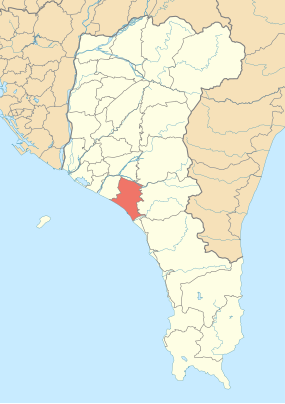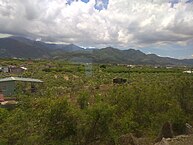Fangliao
|
Fangliao 枋寮 鄉 |
||
 Location of Fangliao in Pingtung County |
||
| State : |
|
|
| County : | Pinging | |
| Coordinates : | 22 ° 24 ' N , 120 ° 36' E | |
| Area : | 57.7347 km² | |
| Residents : | 24,159 (June 2019) | |
| Population density : | 418 inhabitants per km² | |
| Time zone : | UTC + 8 (Chungyuan time) | |
| Telephone code : | (+886) (0) 8 | |
| Postal code : | 940 | |
| ISO 3166-2 : | TW-PIF | |
| Community type : | Rural community ( 鄉 , Xiāng ) | |
| Structure : | 15 villages ( 村 , Cūn ) | |
| Website : | ||
|
|
||
Fangliao ( Chinese 枋寮鄉 , Pinyin Fangliao Xiang , W.-G. catch one -liao 23 Hsiang 1 , PEH OE jī CPang-Liau-hiong ) is a rural municipality in Pingtung County on Taiwan ( Republic of China ).
location
Fangliao is located on the south coast of Taiwan, on the western edge of the central mountains and at the southeast end of the Pingtung Plain . The neighboring communities are Fangshan in the south, Chunri and Laiyi in the east, Xinpi in the north and Linbian in the west. The community is bordered by the sea (the Taiwan Strait ) to the southwest .
history
The first Han Chinese settlers came to the country in 1693, during the reign of Kangxi from the Chinese coastal province of Fujian . The place name 枋寮 , Fāngliáo literally means "(sandel) wood hut" and indicates the earlier importance of wood extraction. After the shipwreck of the American merchant ship Rover and the subsequent American punitive expedition to Formosa in 1867 , the Qing administration increasingly penetrated southern Taiwan and the town of Fangliao was incorporated into the administrative district of Fengshan ( 鳳山縣 ). At the time of the Japanese rule (1895-1945), Fangliao was reorganized into a "village" ( 枋寮 庄 , Fāngliáo Zhuāng ) in 1920 . After the Republic of China took over Taiwan in 1945, the village became a rural community ( 鄉 , Xiāng ) in Pingtung County, which was newly founded in 1950.
population
According to official statistics, at the end of 2017 694 people (around 2.9%) belonged to the indigenous peoples . That was roughly the Taiwanese average.
| Outline of Fangliao |

|
Administrative division
Fangliao is divided into 15 villages ( 村 , Cūn ):
1 Zhongliao ( 中 寮村 )
2 Baosheng ( 保 生 村 )
3 Longshan ( 隆 山村 )
4 Anle ( 安樂 村 )
5 Fangliao ( 枋寮 村 )
6 Neiliao ( 內 寮村 )
7 Renhe ( 人和 村 )
8 Dili ( 地利 村 )
9 Xinlong ( 新 龍 村 )
10 Dazhuang ( 大 庄村 )
11 Donghai ( 東海 村 )
12 Tianshi ( 天時 村 )
13 Xinkai ( 新 開 村 )
14 Taiyuan ( 太 源 村 )
15 Yuquan ( 玉泉 村 )
traffic
Provincial road 1 runs through Fangliao from the north-northwest to the south. Provincial road 17 branches off from here and runs along the coast to the west. County road 185 runs in a north-south direction before it also joins Provincial Road 1. The station of Fangliao forms the southern end point of the Pingtung-line and at the same time the starting point of Südverbindungslinie illustrating the railway connecting the railways of the West Coast and the East Coast of Taiwan. There is also Donghai train station in Fangliao along the Pingtung Line.
Agriculture and fishing
Originally, rice cultivation dominated in Fangliao. From the 1950s onwards, fruit growing increased. A well-known product of Fangliaos are Java apples . The culture of mango trees is also important . Fangliao also has a small fishing port.
Tourism, sightseeing
There are several temples in Fangliao, including the Bao'an Temple ( 北 勢 寮 保安 宮 , Běishìliáo Bǎo'ān Gōng ) from 1785 in the village of Zhongliao, which has undergone multiple modifications and additions over the years (1867, 1929 , 1973, 2006–2009) and the Dexing Temple ( 德興 宮 , Déxìng Gōng ) in the village of Fangliao, a Mazu temple dating back to 1830.
In the coastal area, Fangliao is strongly influenced by fishing and aquaculture.
Web links
Individual evidence
- ↑ 枋寮. zh.wiktionary, accessed July 18, 2019 .
- ↑ 歷史 沿革 ("Historical Development"). Fangliao website, accessed July 18, 2019 (traditional Chinese).
- ↑ 原住民 戶數 及 人數 Households and Persons of Indigenous People. (xls) Taiwan Ministry of the Interior, accessed August 4, 2018 (Chinese, English).
- ↑ 農漁 特 產品 ("Products of Agriculture and Fisheries"). Fangliao website, July 12, 2019, accessed July 18, 2019 (Chinese (traditional)).
- ↑ 枋寮 漁港 (fishing port). Fangliao website, July 12, 2019, accessed July 18, 2019 (Chinese (traditional)).
- ↑ 水底寮 保安 宮 ("Beishiliao Bao'an Temple").文化 資源 地理 資訊 系統 (Academia Sinica Geographical Information System for Cultural Resources), June 14, 2011, accessed on July 20, 2019 (Chinese (traditional)) .
- ↑ 保安 宮 ("Bao'an Temple"). Fangliao website, July 12, 2019, accessed July 18, 2019 (Chinese (traditional)).
- ↑ 枋寮 德興 宮 (“Temple of Dexing at Fangliao”).文化 資源 地理 資訊 系統 (Academia Sinica Geographical Information System for Cultural Resources), June 17, 2011, accessed on July 20, 2019 (Chinese (traditional)).
- ↑ 德興 宮 ("Dexing Temple"). Fangliao website, July 12, 2019, accessed July 18, 2019 (Chinese (traditional)).
- ↑ 休閒 漁業 - 養殖 生產 體驗 園區 ("Recreational fishing - Aquaculture production adventure park"). Fangliao website, July 12, 2019, accessed July 20, 2019 (Chinese (traditional)).



